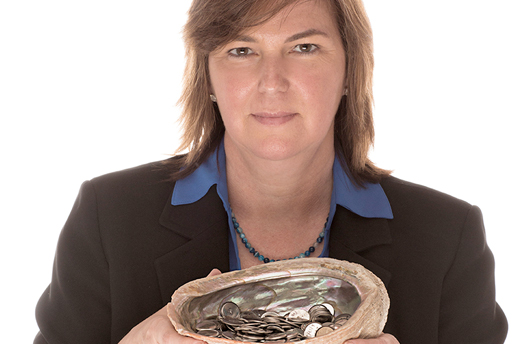
MIT professor Angela Belcher, one of the world’s leading nanotechnology experts, has been named the recipient of this year’s $500,000 Lemelson-MIT Prize, which honors an outstanding inventor dedicated to improving the world through technological invention.
“It feels fantastic,” says Belcher, the W.M. Keck Professor of Energy at MIT and a faculty member at the Koch Institute for Integrative Cancer Research. “There’s been so many great people who have won it in the past. I feel very fortunate.”
Belcher, who heads up the Biomolecular Materials Group at MIT, draws her scientific inspiration from nature’s ability to create materials — such as a snail’s ability to grow its shell. In the lab, she combines organic and inorganic materials to create novel electronic materials for a variety of applications, such as solar cells, fuel, environmentally friendly batteries and medical diagnostics, among other things.
“Angela Belcher is an extraordinary inventor,” says Joshua Schuler, executive director of the Lemelson-MIT Program. “She has taken a single idea and applied it to develop a remarkable portfolio of inventions that span a multitude of industries and will ultimately benefit business, society and the environment.”
“Most impressive,” he adds, “is that Angela never fails to remember the immense value of youth mentorship and its ability to inspire the next generation of inventors who, like Angela herself, will continue to improve the world through their discoveries.”
Inspired by nature
Initially, Belcher was scientifically motivated by the shell of the abalone (a type of sea snail), which she encountered while spending time near the ocean as an undergraduate at the University of California at Santa Barbara (UCSB). (This particular snail would later become the focus of her PhD dissertation.)
The abalone shell is comprised of 98 percent calcium carbonate — an inorganic compound — and 2 percent organic protein, a combination that makes the shell exceptionally strong. This principle — how marine life evolved to make such hard materials from its environment — led Belcher down her path of bio-inspired innovation. Today, her group focuses on coaxing biological materials to work with inorganic materials, such as electronics.
One of her recent inventions is a lithium-ion battery powered by engineered viruses. The batteries have the same energy capacity and power performance as state-of-the-art rechargeable batteries being considered to power plug-in hybrid cars, and they could also be used to power a range of personal electronic devices.
Belcher has applied the same process to improve the efficiency of alternative solar cells such as dye-synthesized solar cells by genetically engineering viruses to more efficiently collect electrons in the solar-cell system, improving the energy production by 33 percent. Belcher’s method adds just one simple step to standard manufacturing of this type of solar cell, making it possible to implement in existing facilities.
Belcher’s technology has given rise to two companies. In 2004, she co-founded Cambrios Technologies, which develops electronic materials for transparent coatings used for touch screens, LCDs and other devices. In 2007, Belcher co-founded Siluria Technologies, which converts lower-value methane gas into high-value liquid transportation fuel.
“The full implications of Angela Belcher’s work are only beginning to be realized, and yet the applications already appear to be far-reaching,” says Evelyn Hu, co-founder of Belcher’s two companies and the Gordon McKay Professor of Applied Physics and Electrical Engineering at Harvard University. “Her inventions are always linked back to her profound passion and compassion for society, and her desire to improve the quality of life for others.”
Supporting the sciences
Belcher says she plans to allocate a portion of the award money to developing outreach programming focused on getting young children excited about science and bringing “cutting edge and state of the art technology into the classroom.”
Inspiring kids to take up science, technology, engineering and mathematics (STEM) education is vital, she says. “The basis of solving many of the pressing global problems — such as energy, health and food — lies in basic science and technological advances that the next generation can help develop,” she says. “We need to show the youth that STEM is exciting and has a huge impact on society.”
Belcher has spoken widely and tirelessly to student groups around the world about science. She visits elementary schools, where she hosts “Chemistry Circuses,” inspiring the young students by helping them to isolate DNA from their cheeks or build their own solar cells. She often mentors middle school girls in science and math, and has worked with IBM to provide lectures on nanoscience for high school students around the country.
Belcher will accept her award at MIT during the Lemelson-MIT Program’s seventh annual EurekaFest, being held June 20-22. Additionally, she will speak at EmTech MIT, the annual conference on emerging technologies hosted by MIT Technology Review at the MIT Media Lab on Oct. 9-11.
The Lemelson-MIT Program — which was formed in 1994 at MIT by one of the world’s most prolific inventors, Jerome Lemelson — celebrates outstanding innovators and inspires young people to pursue creative lives and careers through invention
Material from a Lemelson-MIT Program press release was incorporated into this story.
This article appears in the Autumn 2013 issue of Energy Futures.